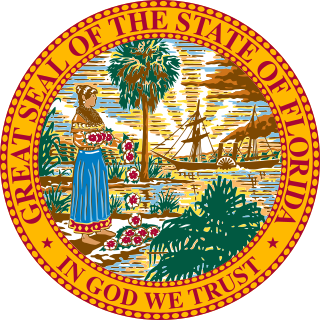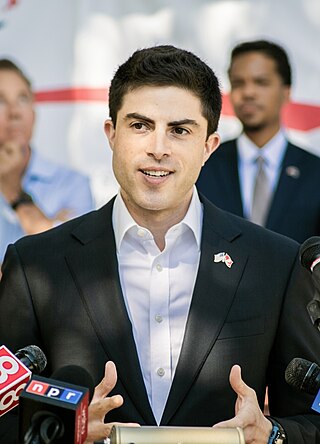
The Seventeenth Amendment to the United States Constitution established the direct election of United States senators in each state. The amendment supersedes Article I, Section 3, Clauses 1 and 2 of the Constitution, under which senators were elected by state legislatures. It also alters the procedure for filling vacancies in the Senate, allowing for state legislatures to permit their governors to make temporary appointments until a special election can be held.

The Equal Rights Amendment (ERA) is a proposed amendment to the United States Constitution that would explicitly prohibit sex discrimination. It is not currently a part of the Constitution, though its ratification status has long been debated. It was written by Alice Paul and Crystal Eastman and first introduced in Congress in December 1923. With the rise of the women's movement in the United States during the 1960s, the ERA garnered increasing support, and, after being reintroduced by Representative Martha Griffiths in 1971, it was approved by the U.S. House of Representatives that year, and by the U.S. Senate in 1972, thus submitting the ERA to the state legislatures for ratification, as provided by Article Five of the United States Constitution. A seven-year, 1979, deadline was included with the legislation by Congress. A simple majority of Congress later extended the deadline to 1982. Both deadlines passed with the ERA three short of the necessary 38 states for ratification. Even so, there are ongoing efforts to ratify the amendment.

The Twenty-third Amendment to the United States Constitution extends the right to participate in presidential elections to the District of Columbia. The amendment grants to the district electors in the Electoral College, as though it were a state, though the district can never have more electors than the least-populous state. How the electors are appointed is to be determined by Congress. The Twenty-third Amendment was proposed by the 86th Congress on June 16, 1960; it was ratified by the requisite number of states on March 29, 1961.

The Florida Legislature is the legislature of the U.S. state of Florida. It is organized as a bicameral body composed of an upper chamber, the Senate, and a lower chamber, the House of Representatives. Article III, Section 1 of the Florida Constitution, adopted in 1968, defines the role of the legislature and how it is to be constituted. The legislature is composed of 160 state legislators. The primary purpose of the legislature is to enact new laws and amend or repeal existing laws. It meets in the Florida State Capitol building in Tallahassee.

The Child Labor Amendment (CLA) is a proposed and still-pending amendment to the United States Constitution that would specifically authorize Congress to regulate "labor of persons under eighteen years of age". The amendment was proposed on June 2, 1924, following Supreme Court rulings in 1918 and 1922 that federal laws regulating and taxing goods produced by employees under the ages of 14 and 16 were unconstitutional.

The Tennessee General Assembly (TNGA) is the state legislature of the U.S. state of Tennessee. It is a part-time bicameral legislature consisting of a Senate and a House of Representatives. The Speaker of the Senate carries the additional title and office of Lieutenant Governor of Tennessee. In addition to passing a budget for state government plus other legislation, the General Assembly appoints three state officers specified by the state constitution. It is also the initiating body in any process to amend the state's constitution.

The Washington State Legislature is the state legislature of the U.S. state of Washington. It is a bicameral body, composed of the lower Washington House of Representatives, composed of 98 Representatives, and the upper Washington State Senate, with 49 Senators plus the Lieutenant Governor acting as president. The state is divided into 49 legislative districts, each of which elect one senator and two representatives.

The Mississippi Legislature is the state legislature of the U.S. state of Mississippi. The bicameral Legislature is composed of the lower Mississippi House of Representatives, with 122 members, and the upper Mississippi State Senate, with 52 members. Both representatives and senators serve four-year terms without term limits. The Legislature convenes at the Mississippi State Capitol in Jackson.

The Constitution of the State of Connecticut is the basic governing document of the U.S. state of Connecticut. It was approved by referendum on December 14, 1965, and proclaimed by the governor as adopted on December 30. It comprises 14 articles and has been amended 31 times.
A convention to propose amendments to the United States Constitution, also referred to as an Article V Convention, state convention, or amendatory convention is one of two methods authorized by Article Five of the United States Constitution whereby amendments to the United States Constitution may be proposed: on the Application of two thirds of the State legislatures the Congress shall call a convention for proposing amendments, which become law only after ratification by three-fourths of the states. The Article V convention method has never been used; but 33 amendments have been proposed by the other method, a two-thirds vote in both houses of Congress; and 27 of these have been ratified by three-fourths of the States. Although there has never been a federal constitutional convention since the original one, at the state level more than 230 constitutional conventions have assembled in the United States.

The Oregon Legislative Assembly is the state legislature for the U.S. state of Oregon. The Legislative Assembly is bicameral, consisting of an upper and lower chamber: the Senate, whose 30 members are elected to serve four-year terms; and the House of Representatives, with 60 members elected to two-year terms. There are no term limits for either chamber.

Wisconsin Referendum 1 of 2006 was a referendum on an amendment to the Wisconsin Constitution that would invalidate same-sex marriages or any substantially similar legal status. The referendum was approved by 59% of voters during the general elections in November 2006. All counties in the state voted for the amendment except Dane County, which opposed it. The constitutional amendment created by Referendum 1 has been effectively nullified since June 26, 2015, when the United States Supreme Court ruled in Obergefell v. Hodges that state-level bans on same-sex marriage are unconstitutional.

South Dakota Amendment C of 2006 is an amendment to the South Dakota Constitution to make it unconstitutional for the state to recognize or perform same-sex marriages, or to recognize civil unions, domestic partnerships, or other quasi-marital relationships regardless of gender. The referendum was approved on 7 November 2006 by 52% of the state's voters.

Idaho Amendment 2 of 2006 is an amendment to the Idaho Constitution that made it unconstitutional for the state to recognize or perform same-sex marriages or civil unions.

The 2007 Texas constitutional amendment election took place 6 November 2007.

Oregon Ballot Measure 54 (2008) or House Joint Resolution is a legislatively referred constitutional amendment that removed provisions relating to qualifications of electors for school district elections. The measure is a technical fix designed to remove inoperative provisions in the Oregon Constitution which barred those under 21 from voting in school board elections and required voters to be able to pass a literacy test to vote in school district elections. This measure appeared on the November 4, 2008 general election ballot in Oregon. It was passed by voters, receiving 72.59% of the vote.

Various kinds of elections in Connecticut occurs annually in each of the state's cities and towns, the exact type of which is dependent on the year. Elections for federal and statewide offices occur in even-numbered years, while municipal elections occur in odd-numbered ones. The office of the Connecticut Secretary of State oversees the election process, including voting and vote counting. In a 2020 study, Connecticut was ranked as the 20th easiest state for citizens to vote in.
The Constitution of the United States provides several basic requirements for eligibility to be elected to the office of President. Individual states did not introduce significant relevant legislation until the 2008 election of Barack Obama, when a controversy known as the birther movement was promoted by various conspiracy theorists. The "birthers" asserted during the 2008 presidential election campaign that Obama was not a natural-born U.S. citizen, as mandated by the Constitution, and thus was ineligible to be President of the United States, prompting several state legislatures to consider legislation aimed at requiring future presidential candidates to provide proof of citizenship by birth before being granted ballot access in their state. None of these efforts led to the passage of currently active laws.

Matthew S. Blumenthal is an American politician and attorney serving as a member of the Connecticut House of Representatives from the 147th district in Fairfield County.















